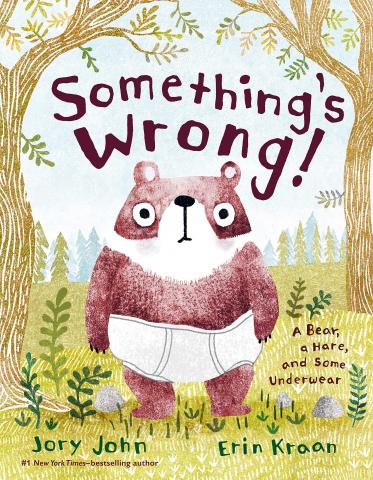
Oh the (In)Humanity
by Seth Warburton
Books give readers the opportunity to look through the eyes of all sorts of people, and sometimes even take the point of view of characters that aren’t “people” at all. Animal characters, for example, are a staple of children’s literature. They make for cute illustrations, of course, but there’s often more to it than that. John Jory and Erin Kraan’s picture book “Something’s Wrong” features a self-conscious bear named Jeff who walks out into the woods one morning with the conviction that something isn’t quite right. The child you read it to will notice the problem immediately, many pages before Jeff does; he’s left his house wearing nothing but his underpants. No wonder his neighbors are giving him all those uncomfortable looks. Thankfully, Jeff’s friend Anders the hare has an idea to fix Jeff’s problem. Kids will empathize with Jeff’s embarrassment and take comfort in Anders’s friendship, but they could do that even if Jeff and Anders were human. So why depict them as animals? Therein lies the humorous twist. Jeff’s fashion faux pas isn’t that he’s worn only underpants, but that he’s worn any sort of clothing whatsoever. He is a bear after all, silly reader, why would you think he needed underpants?
Non-human characters can help readers flex their empathy muscles by allowing them to see from new perspectives. Author Jo Walton provides just such an opportunity for adult readers in “Tooth and Claw.” The siblings at the center of Walton’s neo-Victorian novel squabble over a complicated family inheritance, rue that they can’t afford the latest style of hat and wring their hands about social standing and who should marry who. In short, they do everything you would expect people to do in the sort of historical drama that gets adapted by Masterpiece Theater. Unexpectedly, Walton’s characters are all dragons and live in a world where Victorian morality is biological truth for dragonkind. For a dragon to grow larger and prosper they must eat other dragons. Should any of their tenants’ children grow poorly, landholders are entitled to eat them, ensuring the large grow larger. And as barbaric as this seems, at least the dragons have biological imperatives to influence their actions. What excuse could human Victorians offer, after all, for sending children into dark mines or dangerous factories? Having seen through dragon’s eyes makes it a bit harder to empathize with all those Victorian characters who yearned for a desirable match or a new hat while the nameless poor toil in the background.
Aliens, some of them point of view characters, crop up frequently in science fiction, but too often they’re disappointingly human. Star Trek, for example, makes Vulcans logical and gives them pointy ears, while Klingons get head bumps and anger problems. The aliens in Becky Chambers’s “The Galaxy, and the Ground Within” are thankfully far more interesting. Ouloo runs the Five Hop One Stop, a sort of galactic truck stop on a barren world that happens to lie at the intersection of many galactic trade routes. She is a Laru, four-legged and shaggy-haired, in love with baking desserts, and desperate to impress her guests. When a crisis strands three very different guests, all of different non-human species, at the One Stop, Ouloo’s hospitality is sorely tried. Each species has their own physiology, mindset, and historical animosities. Each individual has their own troubles and personal biases. Can beings as different from each other all exercise the personal decency and tolerance the situation requires? And if we readers can imagine a group as disparate as this cooperating, why is it so difficult to imagine cooperating with our fellow humans when the differences that separate us are as comparatively trivial as the pigment of our skin, who we love, or who we voted for?
If you think you could do with a fresh perspective, or you’d just enjoy looking through the eyes of a dragon, an alien, or even a bear in underpants, you can find these and other great books with non-human characters at the Ames Public Library.